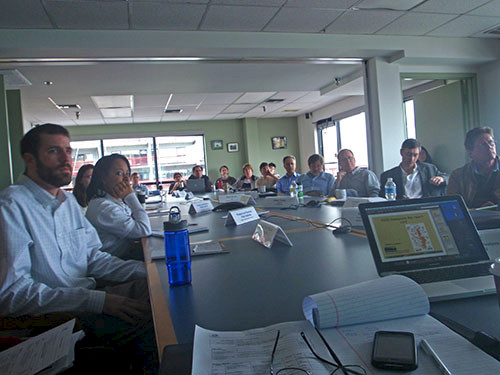Discussion following Walter Boynton seminar on Corsica River estuary restoration
Bill Dennison ·This blog post discusses the seminar given by Dr Walter Boynton, of the Chesapeake Biological Laboratory, at the IAN Seminar Series on March 25, 2010.
If agricultural nutrient management activities like cover crops were instituted, how long would it take to see an effect in the estuary? Time lags were a topic of much discussion regarding the potential delay in restoration progress due to long groundwater residence times. Walter outlined an example in Gunston Cove (a tributary of the Potomac River) in which the phosphorus removal took seven years to manifest itself in the estuary. Following declines in phosphorus levels, chlorophyll declined and then water clarity measured as secchi depth increased. The increased water clarity resulted in submerged aquatic vegetation expansion, seven years after the phosphorus removal. Walter also alluded to research results by Drs. Russ Brinsfield and Ken Staver (see the "Nutrient Management of Delmarva Soils & Waters" newsletter at IAN Press) in which field scale experiments were conducted before and after cover crop application and there was a multi-year lag (3-5 years) following the initial cover crop application before measurable declines in groundwater nutrients were measured.


Walter provided some ecological thresholds: 1) Potomac River submerged aquatic grasses declined when Secchi depth was less than 0.65 m and expanded when Secchi was greater than 0.65 m. The 15°C temperature threshold was when the microbial community in Chesapeake Bay becomes active. The nitrate concentration in rivers and streams of 1 mg/L or less for healthy conditions was inferred from the historical trends—0.3 mg/L in 1903 in the Susquehanna R.; 0.7 mg/L in 1945 and reaching 1 mg/L sometime in the 1960s with the advent of widespread commercial fertilizer use and animal manure production from concentrated feeding areas. It was in the early 1970s that Bay-wide declines in many resources were noted, particularly submerged aquatic vegetation.
Some out-of-the-box thinking was bantered about, including the concept of adding an organic carbon source to shallow nearshore areas receiving high nitrate runoff in order to stimulate denitrification (as occurs in biological nutrient removal in wastewater treatment plants). Denitrification, the conversion of nitrate into harmless nitrogen gas via microbial processes, can alleviate the deleterious impacts of excess nitrogen in the estuary, leading to algal blooms and dead zones (hypoxia/anoxia). Another idea vetted was to add sediments to shallow areas such that the sediments received sufficient light to enhance submerged aquatic grasses and benthic microalgae. This benthic plant life has been shown to trap nutrients in sediments and even absorb them from the water column, thus alleviating symptoms of eutrophication.
Walter provided some specific and general recommendations regarding Chesapeake Bay restoration. He recommended that we attempt to make the Chesapeake watershed 'soggy', that is, to create more ponds, wetlands, riparian vegetation and other devices to retain water on the landscape for longer periods before it made its way into the Bay. He provided examples from the upper Mississippi River, where scientists conducted experiments on river oxbows and observed rapid nitrate disappearance (due to denitrification) when water was retained. He said that the three key elements to Chesapeake Bay restoration were "Retention, Retention and Retention". He joked that we should be making beaver hatcheries instead of oyster hatcheries, but then went on to tell the story of the reappearance of beavers in Calvert County with the initial reaction "the return of nature's engineers" evolving into "tree-killing rodents" as they wrecked havoc with the forests. Walter referred to a seminal paper by Grace Brush estimating the historical beaver populations as being matched by human populations in 1938.
Walter shared his experience on the Calvert County planning commission in which the initial reaction to forcing new home construction to include denitrifying septic systems to be akin to "killing pigs slowly". However, after 18 months, the squealing was replaced with a certain pride in having the state-of-the-art septic systems.
Finally, Walter answered the question of whether or not he was an optimist, as indicating that his cautious optimism could be summarized as money, money and money. Examples included the Maryland flush fee for upgrading sewage treatment, the Maryland restoration fund for enhancing diffuse nutrient removal, the potential of farm bill reauthorizations to enhance agricultural best management practices or the Cardin bill to accelerative Bay restoration implementation.
About the author
Bill Dennison

Dr. Bill Dennison is a Professor of Marine Science and Vice President for Science Application at the University of Maryland Center for Environmental Science.

